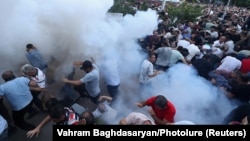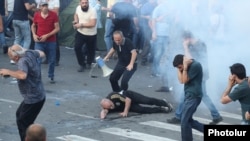Security forces fired an unprecedented number of stun grenades on June 12 as they clashed outside the Armenian parliament with protesters demanding Prime Minister Nikol Pashinian’s resignation. The use of force was strongly condemned by not only the Armenian opposition but also civil society. In a joint statement, 17 mostly Western-funded NGOs described the police actions as “unnecessary, disproportionate and illegal.”
Daniel Ioannisian, a well-known civic activist leading one of those groups, on Wednesday echoed opposition claims that the police used Russian-made Zarya-3 grenades that were not authorized by the Ministry of Health at that point. Ioannisian based his claim on research conducted by his Union of Informed Citizens.
Health Minister Anahit Avanesian added Zarya-3 to the ministry’s list of authorized crowd control equipment only on June 26. Neither she nor her press office has commented on the decision so far.
“They used Zarya-3 when it was not allowed and regulated by the health minister,” Ioannisian told RFE/RL’s Armenian Service. “They then realized that they made a mistake and decided to correct it through the subsequent ministerial order.”
The Armenian Ministry of Interior has still not acknowledged the type of grenades that were indiscriminately hurled at the demonstrators led by Archbishop Bagrat Galstanian. RFE/RL’s Armenian Service sent it relevant written questions nearly a month ago.
According to information posted on a Russian defense industry website, Zarya-3 is “designed to temporarily suppress mental stability of armed criminals with acoustic and light effects, which reduces their combat ability and enables special operations to be carried out with minimal risk to personnel and others.”
Valeri Osipian, a former chief of the Armenian police who had long been involved in crowd control, said that during his service security forces were only allowed to use Zarya-3 for “disarming criminals and gangs.”
“Why? Because injuries caused by them could have irreversible consequences,” explained Osipian. He said that Zarya-3 fragments can potentially kill people.
According to the Ministry of Health, at least 57 of the people hospitalized after the June 12 clashes had shrapnel wounds. One of the injured protesters had three of his fingers amputated as a result.
None of the police officers involved in the crackdown has been fired or prosecuted. Law-enforcement authorities have indicted instead 16 protesters over the “mass disturbances.” Prime Minister Nikol Pashinian has defended the police actions.
Earlier in June, Levon Yeranosian, a former commander of Armenian interior troops, was sentenced to four years in prison for what a Yerevan court deemed an unauthorized and dangerous use of less powerful Zarya-2 stun grenades against Pashinian-led protesters in 2018. Yeranosian avoided imprisonment thanks to a general amnesty declared in 2019. He too insisted on Monday Zarya-3 was never used against protesters before Pashinian came to power.


